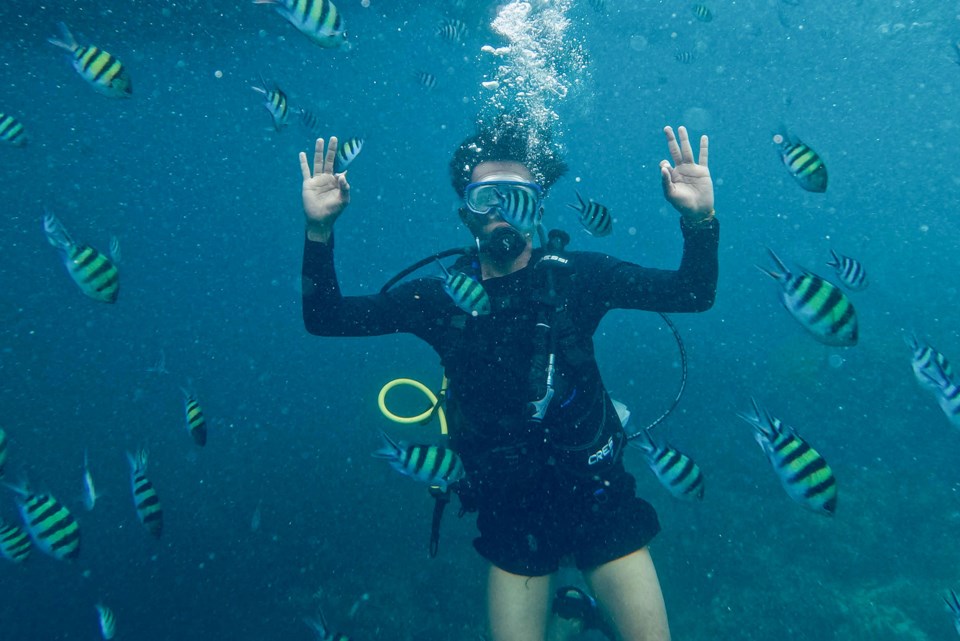Hello to any PelhamToday readers who may have seen my letters to the editor—not the most entertaining and hopefully not all of who I really am!
I am a Brit, born in 1942 (do the math), now a Canadian citizen. I am a professional mariner by trade, fortunate to have experienced the British Merchant Navy, marine pilotage in the UK, the Royal Navy of Oman, then latterly, in my ‘beach bum’ days, captain of a topsail schooner rigged charter boat, a dive instructor, then after arriving in Canada, some years with the CCGA POCOMAR unit as a search and rescue coxswain and some years as a relief captain/crew on the Port Colborne Pilot Boat.
I’m now just a plain retiree, enjoying my home, walking a rambunctious nine-year-old German Shepherd that still thinks he’s a pup, and looking forward to pottering in my vegetable garden once this awful wet winter actually turns to spring.
If you have a moment, I would like to take you on a journey.
It was that time again, and my five students were looking forward to their first open water dive in the clear turquoise waters that surround the Turks and Caicos Islands in the Caribbean. We left our dive base on Provo, bound for West Caicos, an uninhabited quay lying about an hour from our base. The chatter had been all about their first open water dive and what they might see. Sharks were always a topic, some hoping to see them, others not at all sure! I always loved to listen, loved their enthusiasm, their expectations, even their trepidation about this new experience for all of them.
We arrived at the dive site, picked up the mooring buoy, then it was time for the dive brief.
First the necessary safety issues, then the underwater skills they would be completing once we had descended.
Their excitement waned a bit when I told them that once I was satisfied with their skills, we would be finding a small coral outcrop and we would circle it, kneel on the sand, and just observe. As intended, that didn’t go down so well.
Once in the water we went to the mooring, did our final checks, and safely and slowly descended as a group. We were moored in 35 feet of water, beautiful white sand, with a multitude of coral outcrops for as far as the eye could see.
Each of them completed their skills almost flawlessly, as I knew they would, so, onward to the dive that I had briefed. I led them to a coral outcrop and had them all kneel in a circle around it.
You could almost see them rolling their eyes at this weird dive knowing there was a wall just a few fin-kicks away that went down a thousand feet and more, a wall covered with hard and soft corals and incredible marine life.
Then it happened.
One of my students’ eyes suddenly opened wide and she looked down and pointed. She saw a small Fairy Baslet, a tiny, almost iridescent bright blue and yellow fish, followed by a couple more. Then another student tapped his buddy and pointed. He’d spotted an Arrowhead crab. Again, tiny with a small body, very long legs and two feelers with bright blue claws. Then another found he was kneeling close to a cleaning station and saw some pale, almost transparent blue Pederson cleaning shrimps doing their dance and waving their bodies to attract coral fish looking for their cleaning services. Even more! One saw a juvenile Fire Worm, slowly investigating its home. Then a Secretary Blenny popping out of its home in small Brain Coral to feed off tiny algae scraps floating past. There was more small marine life, and it was so awesome to see all of them torn when I signaled we should continue on.
We had a 40-minute dive profile and the students’ maximum depth could be no more than 40 feet so I left just enough time to fin out to the wall, let them see, and imagine the possibilities they would have in the future.
And they did at least get to see a small Hawksbill Turtle and even a small Nurse Shark before we returned to the dive boat.
The debrief? I knew I had them, and though they had seen a shark and a turtle, they were only talking about the incredible macro marine life on that coral outcrop. The best part—all I had to do was to teach them the skills to dive safely, which was the easy part.
It was they who chose to see for themselves what a magical place that underwater world can be in the most basic and simple way.
That was always the best and most rewarding payback for me.


